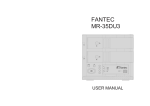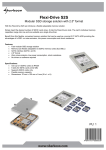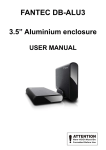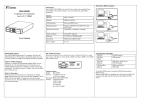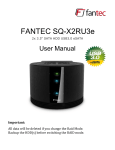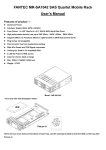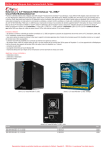Download FANTEC MR-35DU3-6G
Transcript
FANTEC MR-35DU3-6G USER MANUAL Menu Menu ......................................................................................... 1 1. Product Introduction ........................................................... 2 2. Operation.............................................................................. 3 2.1 RAID mode setup ............................................................. 4 2.1.1 JBOD Modus ............................................................. 5 2.1.2 BIG Modus ................................................................ 6 2.1.3 RAID0 ........................................................................ 7 2.1.4 RAID1 ........................................................................ 8 2.1.5 Partitioning Volumes.................................................. 9 3. Note..................................................................................... 13 4. Features.............................................................................. 15 4.1 External storage solution USB 3.0( 5.0 Gbps) ............... 15 4.2 Serial ATA HDD ............................................................. 15 4.3. 4 Working Modes (BIG,JBOD,RAID0,RAID1) ............... 15 4.4 Supported Systems: ....................................................... 18 5. Package content ................................................................ 18 1 1. Product Introduction Enclosure for 2x SATA HDD to USB 3.0. Front Back 2 2. Operation The Hard Disk Installation: Sway from side to side the lock , and pull the doorknob to insert 1 or 2 hard disk. Close the doorknob and the installation will be completed (The step will be represented in terms of following graphs) Note: Sway from side to side the lock at the instructed point which you could open the doorknob to install/unload the hard disk. In contrast, when you sway from side to side the lock at the instructed point then you may not open it. 3 Attention! In order to avoid wrong handling or accidently deleting the data, the initial setup of the RAID mode is always beginning at RAID level JBOD. Afterwards you can set your preferred RAID mode. 2.1 RAID mode setup 1. At first please set the switch for the RAID level selection to JBOD. Now please press the RESET button and power on the device while keeping the RESET button pressed. After about 5 seconds release the RESET button. 2. Shift the RAID level switch to your preferred RAID mode (RAID0 / RAID1 / JBOD / BIG) and power off the unit. 3. Again press and hold the RESET button while powering on the unit and keep it pressed for about 5 seconds. 4 2.1.1 JBOD Modus Insert the two disks in the HDD1 and HDD2 rack and connect the device with the USB & Power cable. Follow the instructions from point 2.1 RAID mode setup. After a few seconds, the computer will automatically recognize the USB device and two new drives should appear. If no new drive shows up, you have to initialize and/or format the disks in the Disk Management (Attention, after formatting all data will be erased) Right-click on “My Computer” click “Manage”, the Computer Management should appear where you choose Disk Management. You should find two new disks flagged as “Unknown” and/or “Unallocated”. Right-click the “Unknown” disk and select “Initialize Disk”, now you can format the disk by right-clicking the “Unallocated” Disk and choose “New Partition” or “Add New Volume”. 5 2.1.2 BIG Modus Insert the two disks in the HDD1 and HDD2 rack and connect the device with the USB & Power cable. Follow the instructions from point 2.1 RAID mode setup. After a few seconds the computer will automatically recognize the USB device. Right-click on “My Computer” click “Manage”, the Computer Management should appear where you choose Disk Management. You should find the new disks flagged as “Unknown” and “Unallocated”. Right-click the “Unknown” disk and select “Initialize Disk”, now you can format the disk by right-clicking the “Unallocated” Disk and choose “New Partition” or “Add New Volume”. 6 2.1.3 RAID0 Insert the two disks in the HDD1 and HDD2 rack and connect the device with the USB & Power cable. Follow the instructions from point 2.1 RAID mode setup. After a few seconds, the computer will automatically recognize the USB device. Right-click on “My Computer” click “Manage”, the Computer Management should appear where you choose Disk Management. You should find the new disks flagged as “Unknown” and “Unallocated”. Right-click the “Unknown” disk and select “Initialize Disk”, now you can format the disk by right-clicking the “Unallocated” Disk and choose “New Partition” or “Add New Volume”. 7 2.1.4 RAID1 Insert the two disks in the HDD1 and HDD2 rack and connect the device with the USB & Power cable. Follow the instructions from point 2.1 RAID mode setup. After a few seconds, the computer will automatically recognize the USB device. Right-click on “My Computer” click “Manage”, the Computer Management should appear where you choose Disk Management. You should find only one new disks flagged as “Unknown” and “Unallocated”. Right-click the “Unknown” disk and select “Initialize Disk”, now you can format the disk by right-clicking the “Unallocated” Disk and choose “New Partition” or “Add New Volume”. Note: When one of the hard disk is crashed, the new hard drive has to be replaced while the device is running! Turn the unit off and remove the faulty hard disk. At the next step turn on the unit with the functional hard drive and wait for about 30 seconds. Then insert the new hard drive into the bay from which you removed the faulty drive. The recovery of the data will start automatically and is indicated by the blinking status LEDs on the left side of the enclosure. 8 2.1.5 Partitioning Volumes This section explains how to partition volumes after initializing them. You must partition volumes for the host computer's operating system before you can store data on the volumes. Refer to the operating system's documentation for further guidance. Partitioning a hard drive MS Windows Important: Before reconfiguring a volume, back up your data and delete previously defined partitions. If no hard disk drives are connected to the device, the disks appear as "Not Initialized" with no capacity allocated to it. Do not initialize or modify that device. 1. Right-click the My Computer icon on your desktop and select Manage from the pop-up window. 2. Select Disk Management under Storage to open the Windows Disk Manager. 9 Every disk should appear with the word “Basic”, a size value that shows the available storage capacity, and a status of “Online”. Instead of Basic, a disk could appear Unknown, Dynamic, or Not Initialized. A window opens with the selected disk (all Unknown disks may appear in this window). Make sure the box next to each disk is checked and click OK. The disk should now be marked as a Basic disk. If a disk appears as “ Dynamic”, right-click the disk icon, and select Revert to Basic Disk. Within a few seconds, the disk should be marked as a Basic disk. If a disk is marked “Not Initialized”, right-click the disk icon and select Initialize Disk. An additional dialog box appears allowing you to select which disks to initialize. Uncheck the Disk item and click OK. Within a few seconds, the selected disk(s) should be marked as a Basic disk. 3. Right-click the configured disk's unallocated space and select New Partition. If the New Partition option is not available, select the disk and initialize it first. To do this, right-click on the disk item and select „Initialize Disk". 4. Click Next to start the Partition Wizard. 10 5. Select the Primary or Extended option and click Next. 6. Specify the partition size. By default, the partition occupies the entire volume. Click Next. 7. Assign a drive letter or mount path and click Next. 8. Name and format the partition and click . 9. Review the file system settings and click to create the logical partition. 11 Mac OS X Important: Before reconfiguring a volume, back up your data and drag the old drive to the trash to un-mount previously defined partition. If no hard drives are connected to the Storage Appliance, the Processor disk (8.0 GB Config Disk Media) will appear. Do not remove or modify that partition. After you configure and partition the new volumes, restore the backed-up data to the new configuration. 1. Launch Disk Utility from the Application > Utilities folder. 2. Select a configured disk and click the Partition tab. This procedure illustrates the BIG Storage Policy configuration, which concatenates the capacity of all hard drives connected to the device. 3. Select 1 Partition from the Volume Scheme drop-down list. 4. Enter a name for the volume in the Name field (such as “My BIG disk”.) 12 5. Select Mac OS Extended (journaled) from the Format drop-down list. 6. Specify the size of the partition in the Size field. 7. Click the Partition button. 8. Click Partition to acknowledge the warning. Disk Utility mounts the created partition and represents it with an icon on the desktop. The icon is labeled with the partition name. 3. Note 1. If this product is in use for the first time or the mode (BIG, JBOD, RAID0, RAID1) is changed; we must initialize and format the HDD before. (All information will be eliminated when format hard drives) 2. If you require a faster data transfer, RAID0 MODE will be suggested to use. 3. If you require a higher data security, RAID1 MODE will be suggested to use. 4. If you require a bigger hard disk capacity, BIG MODE will be suggested to use. Attention: 1. If you use two HDD simultaneously and discover that the LED1 or LED2 flashing with purple lights in turn for a long time. Please check and see if the HDD has installed correctly. 2. If you simultaneously use two HDD, and the HDD damaged under RAID0, JBOD, and BIG pattern, the data on the HDD will lose. Under the RAID1 pattern, you may consider to take out the damaged HDD and replace it by a new HDD instead. 13 LED condition: Switch on power and insert two HD in terms of different working pattern PATTERN HDD carries on the self-checking RAID0 HDD1 and HDD2 LED flashing in turn with purple lights. Self- checking completes when LED shows blue light RAID1 JBOD BIG Data transmission During Data transmission: The HDD1 and the HDD2 LED flashing with purple light. The Data transmission completes when LED shows the blue light HDD1 and HDD2 LED flashing in During Data transmission: The turn with purple lights. HDD1 and the HDD2 LED flashing Self- checking completes when LED with purple light. The Data shows blue light transmission completes when LED shows the blue light HDD1 and HDD2 LED flashing in During Data transmission: turn with purple lights. LED flashing with purple light while Self- checking completes when LED operating different HDD. The Data shows blue light transmission completes when LED shows the blue light HDD1 and HDD2 LED flashing in During Data transmission: The turn with purple lights. HDD1 and the HDD2 LED flashing Self- checking completes when LED with purple light. The Data shows blue light transmission completes when LED shows the blue light After power on and insertion of one or two HD the following LED states appear after a HD failure. (In this example HDD1 is normal and HDD2 is damaged, otherwise vice versa) PATTERN HDD carries on the self-checking Data transmission RAID0 HDD1 and the HDD2 LED flashing in turn with purple lights. Self checking completes when the HDD1 LED shows blue light, and the HDD2 LED goes out. HDD1 and the HDD2 LED flashing in turn with purple lights. Self checking completes when the HDD1 LED shows blue light, and the HDD2 LED goes out. No transmission possible RAID1 JBOD HDD1 and the HDD2 LED flashing in turn with purple lights. Self checking completes when the HDD1 LED shows blue light, and the HDD2 LED goes out. BIG HDD1 and the HDD2 LED flashing in turn with purple lights. Self checking completes when the HDD1 LED shows blue light, and the HDD2 LED goes out. 14 Under the Data transmission condition: The HDD1 LED flashing with purple light, and the HDD2 LED flashing in turn with purple lights. The Data transmission completes when HDD1 LED shows blue light and the HDD2 LED goes out. Under the Data transmission condition: The HDD1 LED flashing with purple light, and the HDD2 LED flashing in turn with purple lights. The Data transmission completes when HDD1 LED shows blue light and the HDD2 LED goes out. No transmission possible 4. Features 4.1 External storage solution USB 3.0( 5.0 Gbps) The FANTEC MR-35DU3-6G provides the following Serial Advanced Technology Attachment (SATA) features: Automatic negotiation between SATA I (1.5Gbps), SATA II (3.0 Gbps) and SATA III (6.0 Gbps) For detailed information about SATA technology, refer to the following specifications online: http://www.serialata.org/ USB Features The FANTEC MR-35DU3-6G provides the following Universal Serial Bus (USB) features: USB 1.0, USB 2.0 and USB3.0 specification compliance For detailed information about USB technology, refer to the following specifications online: http://www.usb.org/ 4.2 Serial ATA HDD Populated with two Serial ATA (SATA) hard disk drives (HDDs), each unit can manage as much as 12000 gigabytes (12 TB, which is 6 TB per disk) of data, depending on the capacity of the hard disk drives that are installed. By combining multiple units in a daisy-chained hierarchy structure, you can increase the total storage capacity of your system. 4.3. 4 Working Modes (BIG,JBOD,RAID0,RAID1) You can configure the FANTEC MR-35DU3-6G to use any of the following Storage Policies to map the appliance's physical hard drives to virtual drives that are visible to the host computer. The virtual drives are called volumes in the GUI. The host operating system treats each volume as if it were a single physical drive. This virtualization allows you to overcome restrictions that are imposed by physical hard drives, such as speed, storage capacity or data storage reliability 15 BIG The BIG storage policy concatenates a series of physical hard drives as a single large volume; resulting in a seamless expansion of virtual volumes beyond the physical limitations of singularly connected hard drives. BIG storage policy delivers maximum storage space without a single large capacity and costly hard drive. Hard drive A and B are concatenated into a single virtual volume in the Figure below with a storage capacity that is equal to the sum of each of the physical hard drives A and B. JBOD The JBOD (Just a Bunch of Disks) storage policy enables each hard drive to be seen separately as one drive. JBOD storage policy is for a standalone (non-cascaded) Storage Processor or the top-level node of a cascaded configuration, but not for subordinate nodes. In a JBOD configuration, each physical drive is directly exposed. 16 RAID0 The RAID0 storage policy distributes access across all hard disks, also called striping. RAID0 presents the best data speed but no data redundancy. RAID0 storage policy accelerates hard disk operating speed by using many disks in parallel. Hard drive data segments are written to different disks simultaneously which increases performance while sacrificing data redundancy. To implement the RAID0 storage policy, the device creates a single virtual volume that is striped across both hard drives, with a storage capacity that is equal to the sum of both hard disk drives. RAID1 The RAID1 storage policy stores all data in duplicate on separate drives to protect against data loss due to drive failure. One drive mirrors the other at all times. Every write operation goes to both drives. RAID1 provides the highest level of data protection for critical data that you cannot afford to lose if a hard drive fails, but halves the amount of storage capacity because all data must be stored twice. The resulting storage capacity of the virtual RAID1 volume will be equivalent to the size of one hard drive (if both drives are the same) or the smaller of the two drives (if they are different). If one drive fails, the RAID1 volume is still usable, but it is in a vulnerable state because its mirrored hard drive is inaccessible. When the offline drive comes back online, the appliance begins a rebuild process immediately to restore data redundancy. Although the volume remains available during the rebuild process, the volume is susceptible to data loss through damage to the remaining drive until redundancy is restored at the end of the rebuild and verification process. Host access takes precedence over the rebuild process. If you continue to use the SAFE volume during the rebuild, the rebuild process will take a longer time to complete, and the host data transfer performance will also be affected. 17 4.4 Supported Systems: Windows VISTA/7/8/8.1 and MAC OS 9.0 or higher 5. Package content - FANTEC MR-35DU3-6G - User manual - AC Cable - USB Cable CE declaration of conformity http//:www.fantec.de/unternehmen/bestimmungen/ce Model: FANTEC MR-35DU3-6G 18



















